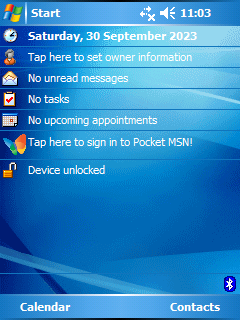| Version of the Windows Mobile operating system | |
 | |
 Today screen of Windows Mobile 5.0 | |
| Developer | Microsoft Corporation |
|---|---|
| Source model | Closed source |
| Released to manufacturing | May 9, 2005 |
| Kernel type | Windows CE |
| Preceded by | Windows Mobile 2003 |
| Succeeded by | Windows Mobile 6.0 |
| Support status | |
| Mainstream support: Ended on October 12, 2010[1] Extended support: Ended on October 13, 2015[1] | |
Windows Mobile 5.0 is a mobile operating system developed by Microsoft. It was originally codenamed "Magneto".[2] It was released at Microsoft's Mobile and Embedded Developers Conference 2005 in Las Vegas, May 9–12, 2005. Microsoft offered mainstream support for Windows Mobile 5 through October 12, 2010, and extended support through October 13, 2015.[3] It was first offered on the Dell Axim x51.
It used the .NET Compact Framework 1.0 SP3, an environment for programs based on .NET. Windows Mobile 5.0 included Microsoft Exchange Server "push" functionality improvements that worked with Exchange 2003 SP2.[4] The "push" functionality also required vendor/device support[5] With AKU2 software upgrades all WM 5.0 devices supported DirectPush.
Windows Mobile 5.0 featured increased battery life due to Persistent storage capability. Previously up to 50% (enough for 72 hours of storage) of battery power was reserved just to maintain data in volatile RAM. This continued the trend of Windows-based devices moving from using RAM as their primary storage medium to the use of a combination of RAM and flash memory (in use, no distinction between the two is obvious to users). Programs and frequently accessed data run in RAM, while most storage is in the flash memory. The OS seamlessly moves data between the two as needed. Everything is backed up in the flash memory, so unlike prior devices, WM5 devices lose no data if power is lost. New to 5.0, OS updates were released as Adaptation kit upgrades, with AKU 3.5 being the final released.
- ^ a b "Windows Mobile 5.0". Microsoft Product Lifecycle. Microsoft Docs. Retrieved April 11, 2022.
- ^ De Herrera, Chris. Windows CE/Windows Mobile Versions. pocketpcfaq.com. Retrieved September 6, 2007.
- ^ "Microsoft Support Lifecycle". Microsoft. January 2009. Retrieved January 9, 2009.
- ^ "New Mobility Features in Exchange Server 2003 SP2". Microsoft Technet. October 2005. Retrieved June 4, 2007.
- ^ Boulton, Clint (October 19, 2005). "Microsoft Looks to Mobilize With Exchange SP2". internetnews. Retrieved June 4, 2007.